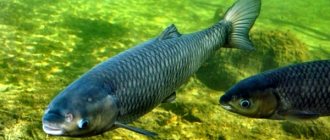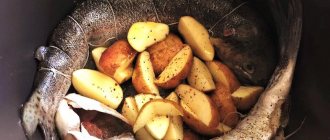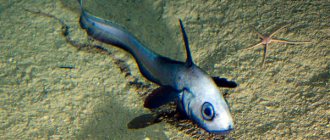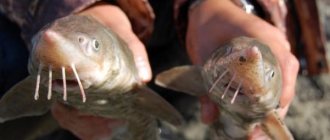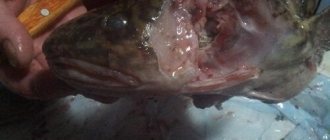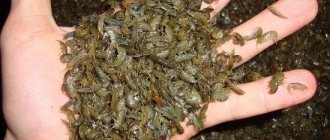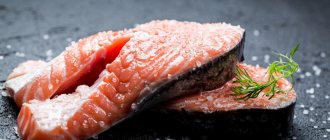Characteristics and differences
The oldest representatives of this genus appeared more than 35 million years ago in European and Asian territories. When comparing the photo with an ordinary roach, it is noticeable that this is not the same thing; the chebak fish, whose second name is “Siberian roach,” has a number of external differences, their description:
- elongated body with large scales;
- the dorsal high fin is not reddish in color;
- Eye color is dark or yellowish, but also not red.
But the lower and side fins look pinkish, the chebak’s light-silver belly is the same as that of the roach, the back is blue-blue or black with a greenish tint.
How to prepare?
Like other types of fish, roach needs to be prepared before cooking. Although small fish are sometimes cooked with scales, both them and large fish must be gutted and cut up.
How to quickly remove scales?
Cleaning a roach is easy. In young fish, the scales can be easily removed even with your hands, and to clean adult fish you can use a knife or a special brush for cleaning fish.
To prevent the scales from scattering in different directions, the roach must be kept under water while cleaning. To do this, pour liquid into a small saucepan or basin and, having immersed the fish inside, run a knife along the entire body, removing the scales. In the same way, you can clean the scales using:
- kitchen grater with large holes;
- special device for cleaning fish;
- a device made with your own hands (3-4 iron lids are nailed onto an oblong piece of wood, the ribbed side of which perfectly cleans the scales).
Using any method, it is worth remembering that the fish is always cleaned in the direction from the tail to the head. You should also trim the fins first to avoid injury while removing the scales.
How to cut and gut?
Before you start preparing the dish, the roach must be gutted and cut up.
To remove the entrails, use a sharp knife to make a cut along the entire length of the belly, widen the hole with your fingers and remove all the entrails. This method of preparing fish is suitable for recipes in which the roach is cooked whole.
You can start cutting roach into fillets without preliminary gutting. First, a cut is made with a knife along the length of the belly, after which, laying the fish on one side, the meat is pryed off at the head fin and cut off all the way to the tail. Having separated one part, the fish is turned over on the other side and the described steps are repeated.
Then they begin to separate the scales: place a piece of fillet on a kitchen board with the meat facing up and, holding the tail end, make an incision as close as possible to the scales and gradually separate it. The cleaned fillet is ready for cooking.
How to make minced roach?
Minced roach is perfect for making fish cutlets. The sequence of preparing minced meat is as follows:
- The fish are washed, cleaned, gutted and heads cut off.
- All fish are passed through a meat grinder or food processor.
- For 1 kg of fish, take 5 medium potatoes and a head of garlic, which are also peeled and ground.
- All ingredients are ground and salt and pepper are added to the minced meat.
Nutrition
The gluttony and omnivorous nature of the chebak is amazing, but thanks to this unpretentiousness, it grows quickly and matures for the reproduction of offspring. The diet includes both plant and animal foods: algae, mollusks, worms, larvae, bottom and crustacean organisms. Caviar of other fish and caddisfly are the favorite delicacy of Siberian roach. In the warm season, when it comes to the surface, it happily swallows mosquitoes, flies, beetles, midges and even small grasshoppers. Lunch in calm weather lasts for the whole day.
Due to its large numbers, gluttony and eating food in a reservoir, lake or pond, the Siberian subspecies affects populations of valuable fish species and therefore needs to be controlled.
Distribution area
Chebak fish is found in large quantities in freshwater Ural, Siberian and Far Eastern lakes, as well as the Tobol, Indigirka, Irtysh and Kolyma rivers. Swims into the rivers of Transbaikalia: Khilok and Chikoy. Favorite places:
- with a not very fast current;
- moderately cold water;
- overgrown with algae;
- with a rocky, snagy bottom with deep holes.
The bottom depression in shallow water covered with vegetation is the favorite habitat of the chebak.
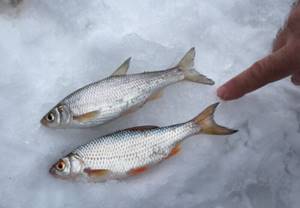
Behavior
It is useful for fishing enthusiasts to know where to look for Siberian roach, at what time and how it behaves. Tree snags sticking out of the water, drifting drifts of driftwood and grassy debris - this is where schools of unpretentious fish hide.
Twice a year, in the second half of summer and closer to autumn, chebak fish gather in small schools and go out to feed closer to the shores; for 10 days they greedily consume algae and small insects. At this time, they are commercially fished. They spend the winter at the bottom, but do not fall asleep, but continue to feed (backwater fish), which pleases winter fishing enthusiasts.
What to catch a chebak with
What to use to catch chebak fish:
- bloodworms and maggots are the most common baits;
- caddisfly;
- worm;
- wheat or semolina dough;
- bread;
- corn;
- peas;
- cereals;
- pasta;
- pearl barley.
In difficult conditions it is often necessary to prepare “sandwiches”; the chebak reacts even better to them. The best sandwich is a combination of maggot, corn and star.
Spawning and natural enemies
By the age of three years of life, the chebak fish begins to spawn, first the youngest individuals go to the spawning ground, after a few days the middle-aged fish, after another 2-3 days, the adult subspecies of roach begins to move along the rivers of the Urals and Siberia.
The process takes a couple, three weeks, considering the progress, the mating games themselves are quite silent. The chebak comes out into shallow water and rubs against all surrounding objects, grass, flooded trees, stones; very often flooded meadows become the spawning site.
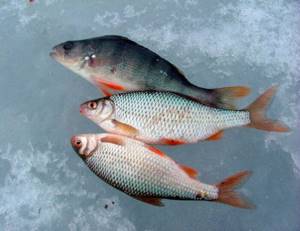
Spawning begins in April-May, when the waters warm up to +8 – +9 degrees, at a depth of 2-10 meters. In cold weather conditions, Siberian roach go to great depths to spawn; in warm weather conditions, they rise to the surface.
The fertility of the females can be envied; from several tens of thousands of eggs (minimum 11,500, maximum 60,000) measuring 2 mm, fry appear in two weeks. The eggs are covered with sticky hairs and are securely attached to snags, stones, and plants. By autumn, the fish grows up to 4-5 cm, thanks to increased feeding on small plankton in the upper layers of water. After spawning, it goes to the depths, where it feeds on worms, mollusks, and algae.
The chebak lives up to a maximum of 10 years, but rarely survives to old age due to natural enemies. This species of roach is an excellent food for predators such as pike, perch, waterfowl (gulls, cormorants, herons); for humans it is a commercial species.
Rich ear
From river fish in the amount of 600 g you can prepare a very tasty and aromatic soup.
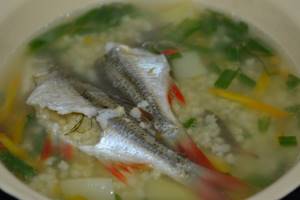
In addition to the main product, you need:
- 4 potato tubers;
- 30 g millet;
- bulb;
- 3-4 sprigs of dill;
- Bay leaf;
- salt and seasonings.
To serve a delicious and rich fish soup from a dietary and nutrient-rich river product to the dinner table:
- The fish is cleaned, gutted and placed in a pan of salted water that has just boiled.
- Quite large pieces are prepared from vegetables.
- After ¼ hour, the chebak is removed from the pan and placed on a plate.
- The broth is filtered, after which vegetables, herbs and bay leaves are added.
- After 10 minutes, millet is poured into the soup.
- After 15 minutes, the ukha is poured into plates, where pieces of boiled Siberian roach are already laid out.
Chebak is an excellent river fish that contains only 100 kcal per 100 g, which makes it an ideal product for a diet menu.
Catching
Medium and small specimens of the chebak are not shy, so even people who have picked up a fishing rod for the first time will be able to catch several kilograms in a short period of time. The end of spring and the month of June, when the fish gather in small schools and come out to feed in shallow water, is the best time for fishing.
Amateur fishermen catch chebak on a float rod, having previously fed it with porridge, corn, steamed peas, pearl barley with a small amount of aromatic additives (spicy, meat, fish). For fishing, it is better to choose a place without a current, shallow water overgrown with algae, reaches. They go out for large fish either in the early morning or closer to night, small and medium-sized fish are caught throughout the day.
The following are used as bait: maggots, worms, bread products, semolina or flour dough, caddis flies, algae, rolled oatmeal flakes. Fishing for a subspecies of roach is easy, it is light (in most cases up to 500 grams) and gets tired quickly, the main thing is not to pull the line under a snag; for this you need to constantly keep it taut. Choose a line of the smallest diameter, working - 0.14 mm, for leashes 0.10-0.12 mm.
Three types of fishing rods are used for bottom fishing:
- Donka with a reel.
- Rubber.
- Feeder.
The reel is taken for 70-100 meters of fishing line - this is convenient for fishing or in case of accidental breakage of gear.

Winter fishing
For winter fishing, fishing rods are used: with a jig with a nod, with a float, for the current. The favorite bait for chebak at this time of year is crushed crackers with sunflower seeds mixed with crushed worms or bloodworms (depending on what the bait will be made of). On the first and last ice, the bite is good, on the established thick frozen layer, chebak fish are caught worse. From this it follows that this subspecies of roach is very dependent on sunlight, the presence of sufficient oxygen and low air temperature. In winter, it is difficult to catch a specimen larger than 300-400 grams, but it is still a desirable trophy, especially for use as live bait for pike fishing.
When fishing with a jig (the main method of Siberian fishermen), they use: bloodworms, maggots, burdock moth larvae, and caddis flies. The game is played with short pauses, but the fish rarely bites on the stand and without bait.
How does it differ from roach and its industrial significance?
The fact that roach and chebak are not the same is noticeable by the difference in appearance. Another thing that distinguishes the fish is that the females mature early and grow faster, but in size and weight, the roach and the chebak look the same. They have no difference in diet and habitat; the Volga roach also lives up to 20 years and is much leaner than its Siberian relative.
Chebachok is not of particular value, it is considered a trash fish, it is consumed as food by people living in the northern regions in fried and dried form, and is rarely used for preparing fish soup (due to its bonyness). It is processed into animal feed and even biofuel. Eating eggs of valuable fish species, extermination of bioplankton - these factors necessitate population control.
Use in cooking
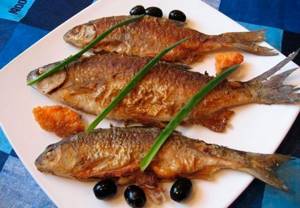
Local residents mainly dry, smoke and fry chebak in flour. Due to the fact that there are quite a lot of bones in this fish, it is not advisable to cook fish soup from chebak, and it boils quickly, so it doesn’t make any fish soup. Small chebak serves as food for domestic animals such as cats, for example.
Chebak is a fairly common fish in the Urals, Siberia and the Far East. Despite the fact that this fish is caught on an industrial scale, it is not particularly valuable. Perhaps for residents of these regions who use chebak in their diet. Chebak, like any other fish, is distinguished by the presence of many nutrients, especially if used raw or semi-raw. Therefore, it is often smoked or dried, since in this form the fish is preserved for a long time.
Catching a chebak is not difficult even with ordinary float tackle; it is enough to seriously prepare for fishing, taking bait and groundbait with you and finding a promising place.
